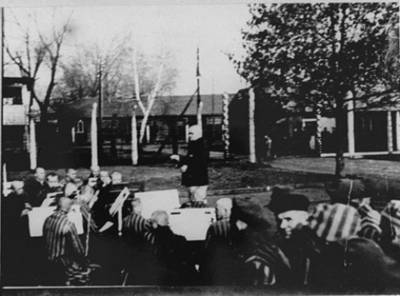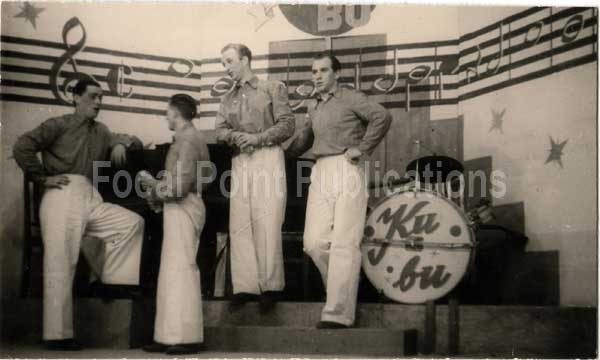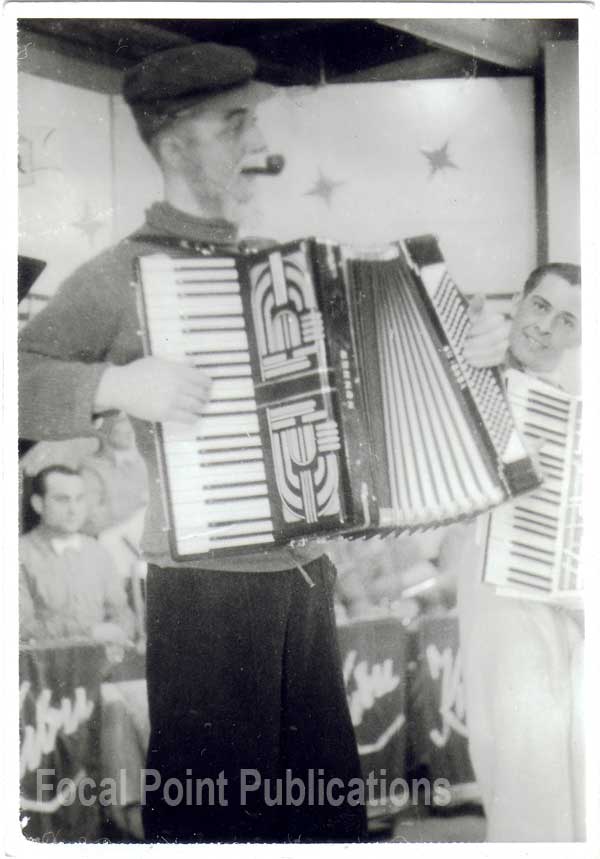
Prisoners Orchestra Sunday concert for SS Auschwitz. USHMM (81216), courtesy of Instytut Pamieci Narodowej.1
Auschwitz
orchestra
[back] Auschwitz-Birkenau
['Auschwitz had up to 16 camp orchestras (with instruments available).1 ]
[vid] Holohoax Survivors who Tell the Truth
Rare photos of one of the camp orchestras at Auschwitz concentration camp Real History: a former camp officer at Auschwitz living in Munich sold to one of us these original snapshots taken of one of the half dozen orchestras and bands formed by inmates of the infamous Auschwitz slave labor camp, the Kubu orchestra, said to have been comprised of Cuban Jews. On the back of some of the five snapshots is a rubber stamp of the Auschwitz camp office, and at some time -- possible after the war -- a German hand has inscribed captions on some of them, as shown below.
'Auschwitz had up to 16 camp orchestras (with instruments available), a camp theatre (where live plays were performed by camp inmate actors), camp sculpture classes (conducted for interested inmates by professional sculptors), camp art classes for inmates, a camp university (with lectures on topics from health, the arts, philosophy, science, economic issues, etc.). Marriages took place (worker inmates fell in love and were allowed to marry their inmate partners there). It had its own Auschwitz maternity ward (over 3,000 live births were registered there, with not a single infant death while Auschwitz was in operation under German rule). The women sections of the camp had female guards. It had a camp post office (with twice weekly pick-ups and deliveries). Check this one out: it even had its own jail (for inmates who committed crimes against another inmate). This next one was a big surprise: it even had a "Camp complaints office” where inmates could register complaints or make suggestions. Camp Commander Höss had a standing order that any inmate could approach him personally to register a complaint about other inmates such as "Kapos" and even guards. It had a system of strict discipline for guards and also for inmates, with punishment being handed out against those found guilty for even slapping an inmate. Etc., etc. Er... is anyone still reading? Or is this too disturbing a subject matter?'----The Human Face of Holocaust Revisionism. A Biographical Reminiscence by Chris Crookes
"The camp housed an elaborate and multi-faceted musical scene. The first prisoner orchestra was set up in the winter of 1941, with Franz Nierychlo as conductor. (The advantages of a prisoner, rather than SS, band—primarily the ability to control musicians as slave labour—led to the decision to gather inmates together to play at camp functions.) The original group of seven musicians, playing first with instruments seized from neighbouring towns, included a violin, contrabass, accordion, trumpet, saxophone and percussion. These were later replaced with better quality instruments sent to the musicians by family members. Their first formal rehearsal was held in Block 24, the basement under the camp brothel, where there was a small podium and a grand piano. This room became known as the concert hall, where the band gave shows for prisoners as well as guards and officials. The audience would stand along the walls; the musicians were scattered throughout the room, sitting wherever they could find a space. The group rapidly expanded to over 100 members. As an increasing number of professional Polish musicians were arrested, the quality of performance improved. (Until the last months of the orchestra, Jews were not allowed to join.)"1

Prisoners Orchestra Sunday concert for SS Auschwitz. USHMM (81216), courtesy of
Instytut Pamieci Narodowej.1


